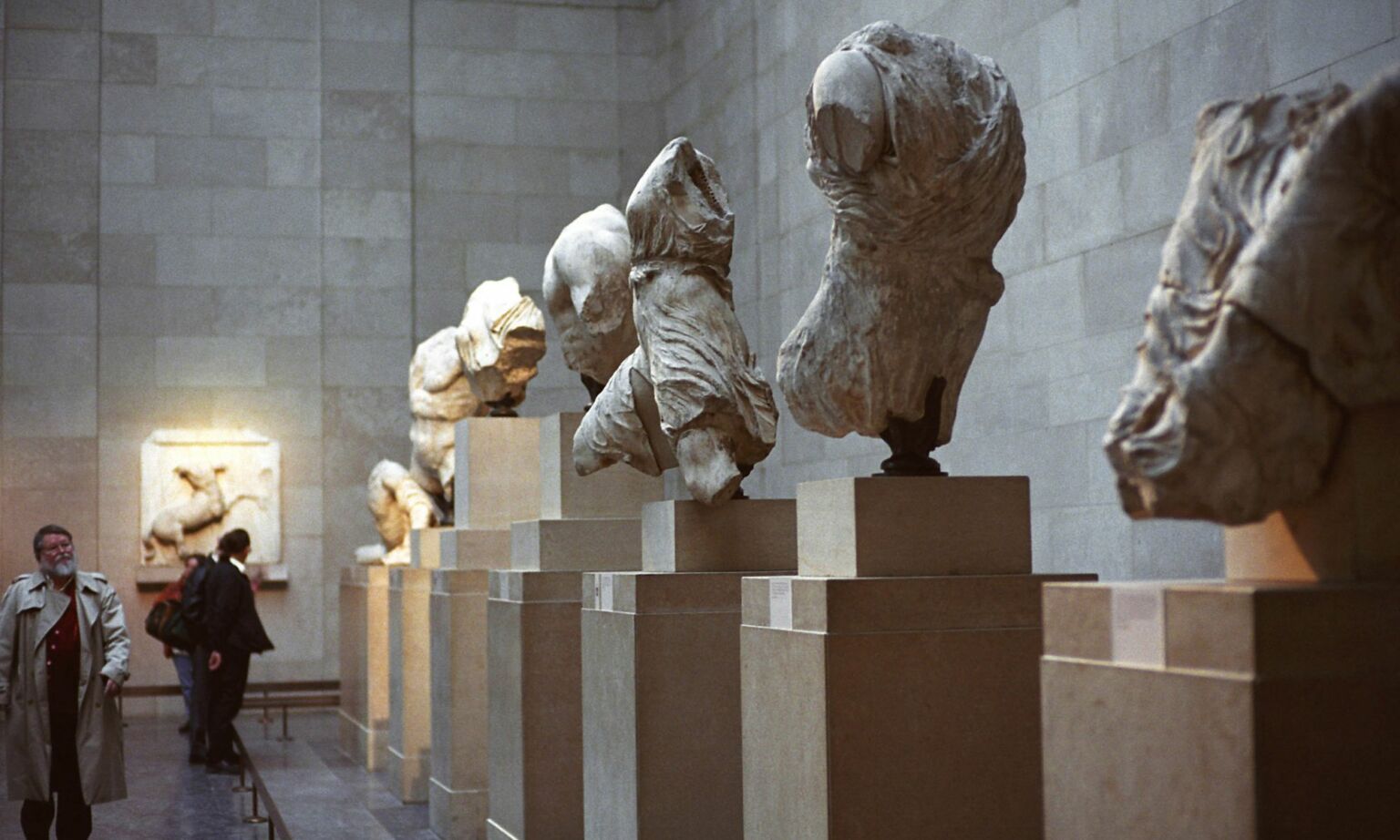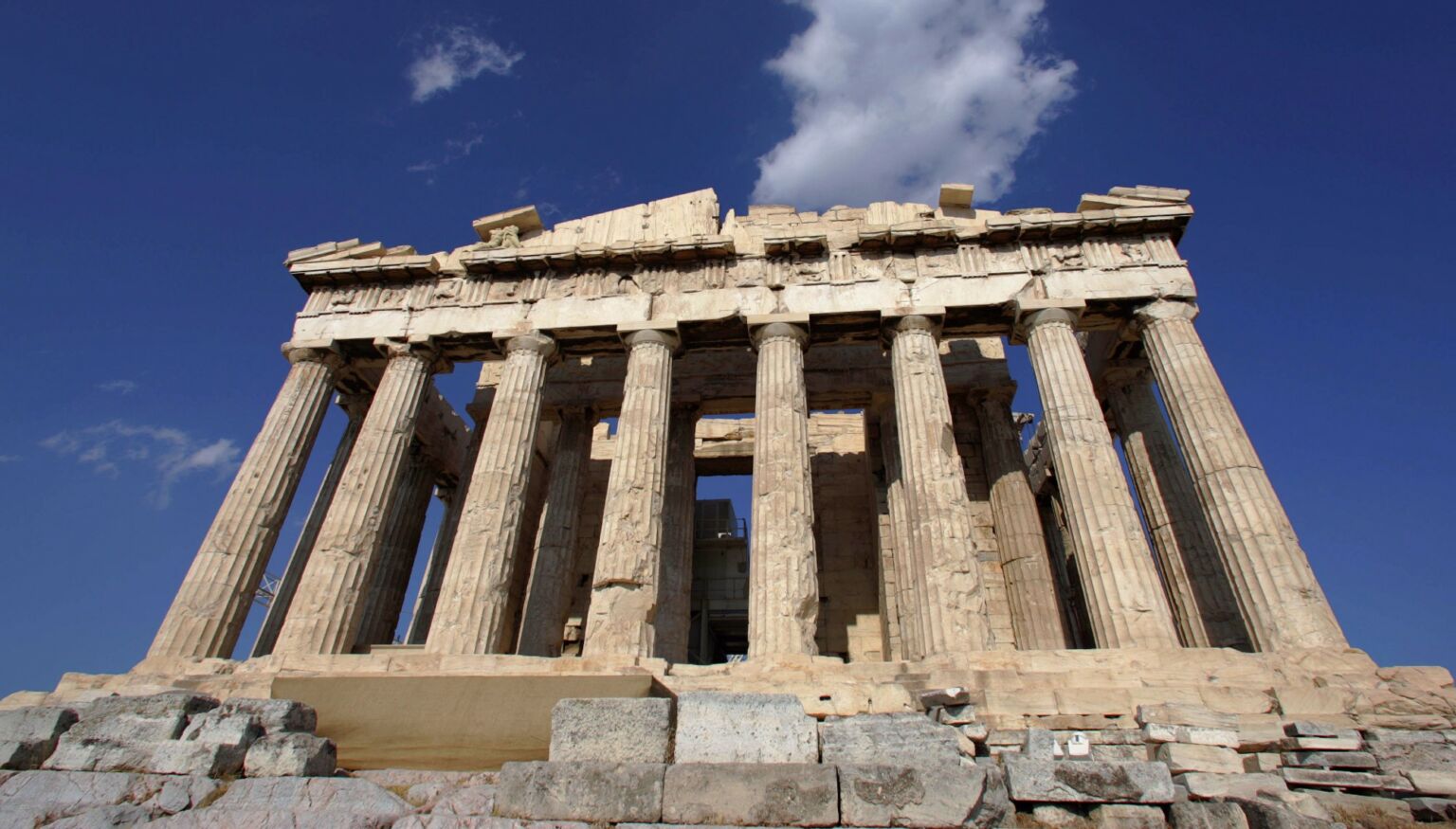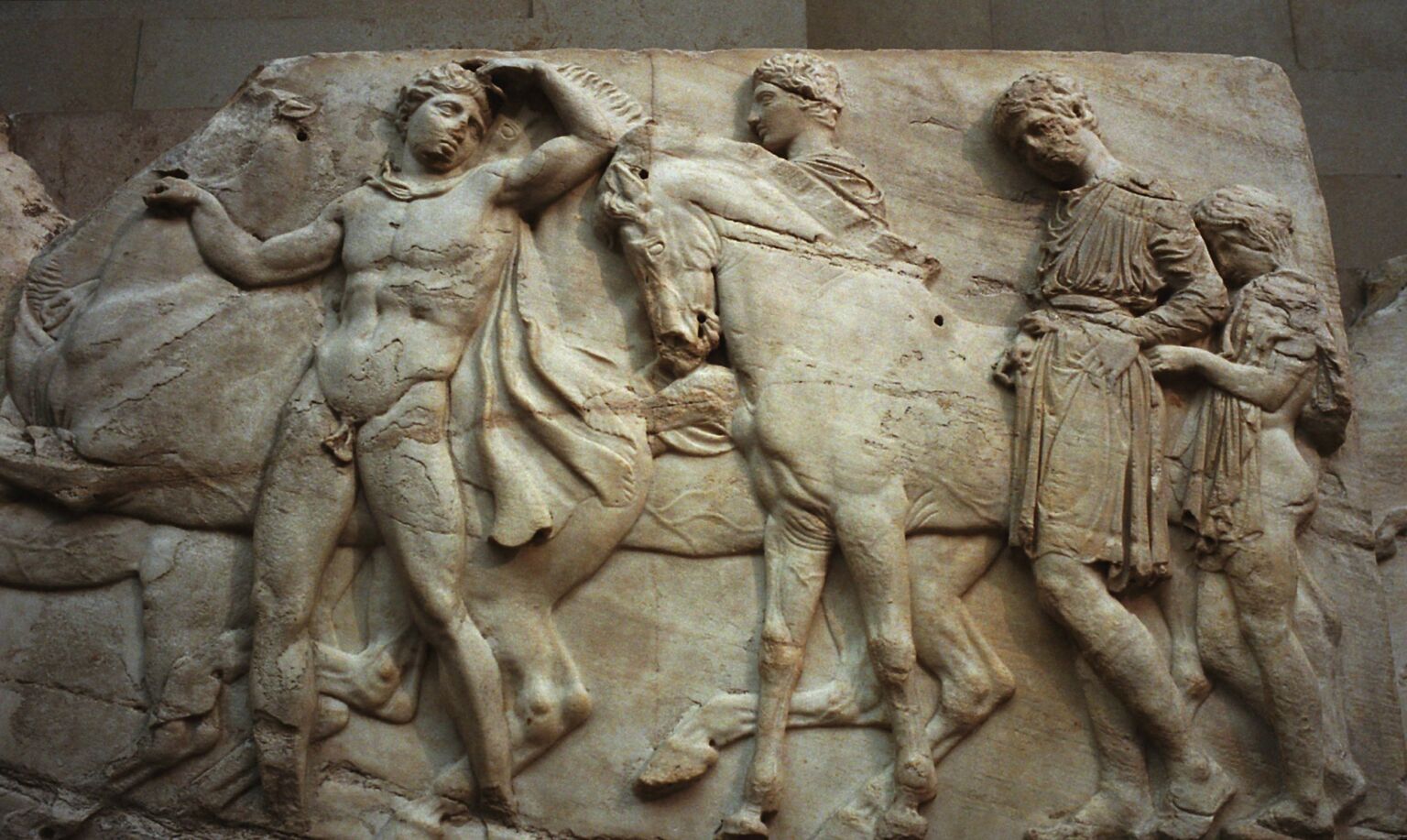
Long-read
Why the Elgin Marbles matter
The row over ownership is obscuring the sculptures' meaning and value.
Want to read spiked ad-free? Become a spiked supporter.
The seemingly never-ending argument over whether the UK should return the Elgin Marbles to Greece erupted again last month.
Greek prime minister Kyriakos Mitsotakis kicked off the latest round during an interview on the BBC’s political show, Sunday with Laura Kuenssberg. He said that keeping the marbles in the British Museum, while the rest of the sculptures from the Parthenon are being kept in the Acropolis Museum in Athens, was like cutting the Mona Lisa in half.
In response, British prime minister Rishi Sunak promptly cancelled a scheduled meeting between the two. No10 claimed that Mitsotakis had gone back on assurances that he wouldn’t use his UK visit as a platform to lobby for the return of the marbles.
This latest row over the Elgin Marbles has been as unedifying as ever. Once again the dispute has been entirely about ownership, with both British and Greek leaders shouting ‘mine’. What politicians and the broader media are again failing to discuss is the meaning and value of the marbles themselves. There is no sense that those shouting loudest about ownership are able to express why the sculptures matter so much. No sense that they value the marbles in and of themselves as works of sublime art.
It hasn’t always been this way, however. Yes, the ownership of the marbles has always been an issue, ever since politician and diplomat Thomas Bruce, otherwise known as Lord Elgin, first procured them in 1801. But crucially the key debates at the time were less about property rights than they were about the aesthetic and cultural importance of the marbles. Recalling these debates, remembering why it is that these sculptures were and are so esteemed, is crucial. Not just for understanding why they ended up at the British Museum. But also for understanding why we ought to value them today, and how we might finally resolve the questions over their future.
The re-discovery of Ancient Athens
The Parthenon sculptures, a portion of which we now know of as the Elgin Marbles, were originally completed in 432 BC and housed in the Parthenon, in the Acropolis of Athens. By the late 18th century, when the then ambassador to Constantinople, Lord Elgin, had begun to take an interest in the relics, few locally were paying them much attention. At that time, Greece was part of the Ottoman Empire. The Acropolis served as a garrison and the Parthenon itself was used as a mosque. Ancient statues were frequently dismantled for use as mortar and locals took away other parts for myriad uses. The whole site was a shanty town, a mass of ruins.

In the modernising West of the 18th century, there was a growing interest in Ancient Greece, fuelled by the Enlightenment and later by Romanticism and a growing cultural nationalism. Many looked to the classical world, particularly during the bloom of Athenian democracy, as a source of artistic, cultural and even political inspiration, a potential model for civic life. It was in the context of this insurgent Hellenism that Lord Elgin decided to employ artists to take casts and drawings of the marbles on the Parthenon floor. In 1801, Elgin went a step further: he obtained a ‘firman’ (an Ottoman permit) to remove certain sculptures from the Parthenon and its environs. Over the course of the next decade, Elgin’s agents removed the marbles and shipped them to Britain.
The decision to acquire the marbles wasn’t without its critics. Romanticism may have heightened the renown of these artefacts, but it also fuelled debates over whether the remnants of the Ancient World should be preserved or allowed to decay into what some viewed as beautiful ruination. Indeed, watching Elgin’s agents at work, the English architect Robert Smirke was moved to lament: ‘Though I was initially pleased with the idea of our country acquiring such valuable remains… I couldn’t help but feel a strong regret when I considered their acquisition as a sort of signal for the annihilation of such captivating moments.’
Elgin had originally intended to house some of the sculptures in his residence, Broomhall House in Scotland. However, Elgin’s personal circumstances had taken a downturn during the early 1800s, as he battled syphilis, endured a divorce from his wealthy wife and lost his seat in the Lords. To alleviate some of his troubles, he decided to sell the sculptures to the British nation.
The House of Commons select committee that investigated Lord Elgin’s proposal in 1816 was nothing if not thorough. It considered four questions: on what authority the marbles from the Parthenon were acquired; the circumstances under which the authority was granted; their financial value; and, above all, the merit of the sculptures.
The select committee’s ruling was unequivocal on the question of ownership. The sculptures had not been looted. Its investigation confirmed that Lord Elgin had received multiple authorisations and confirmations from Ottoman officials to export the sculptures. While a modern-day lawyer could well pick holes in some of the often short and simple agreements (by today’s standards), and Lord Elgin’s men probably exceeded the terms of the firman, no court of law could ever rule in Greece’s favour on the basis of the original permissions and contracts.
Tellingly, the select committee called star artists as witnesses. This shows how concerned the committee was to establish the marbles’ aesthetic and cultural value before committing to purchase them. Though many witnesses gushed, some were more critical. British sculptor John Flaxman conceded he preferred the Roman sculpture, Apollo Belvedere – itself modelled on an earlier Greek bronze sculpture. He described Apollo Belvedere as the very model of perfection, and contrasted it favourably with the battered fragments Lord Elgin had brought back from the Parthenon.
A question of value
Flaxman was far from alone in holding such a view, at least initially. The art works of Ancient Rome, which were hugely popular among collectors at the time, shaped and dominated artistic taste. No one had seen anything like the Greek originals on which many Roman works were based. When English portraitist Ozias Humphry first saw the marbles put on public display in London in 1807, he described them as a ‘mass of ruins’. Like Flaxman, Humphry preferred the revered Roman sculptures. Those were radiant, smooth and gracefully poised. These bits of marble from Ancient Greece were broken, bruised and grey-ish. The figures and scenes they showed appeared distorted and unruly, depicting Athenian gods, goddesses and legendary heroes, and battles between Centaurs and Lapiths. There was even an extraordinary horse-head sculpture with flared nostrils and a pulsating vein down its nose.
But during the 1800s and 1810s, with Lord Elgin exhibiting the marbles at his London residence, public appreciation of these weathered and fragmented Greek sculptures quickly grew.
English painter Benjamin Haydon was captivated by the marbles during his initial visit to see them. On a return trip, he said their impact was even more ‘vivid’. Likewise, Italian neoclassical artist Antonio Canova travelled to see them and swooned. Lord Elgin even talked to Canova about restoring the ‘mutilated’ fragments – adding the missing limbs, polishing them down. Canova dismissed such notions: ‘It would be sacrilege in him or any man to touch them with a chisel.’ Their very existence was an inspiration to modern artists, argued Canova. ‘Oh! That I were a young man, and had to begin again, I should work on totally different principles from what I had done, and form, I hope, an entirely new school.’
Canova’s enthusiasm was increasingly shared by many other artists, cultural figures and even politicians. There was a growing belief that their presence in Britain would lead to an artistic renaissance. Some held out the hope that they would vivify civic life, too – that they could help seed the democratic spirit of the Athenian golden age.
Tory MP John Wilson Croker, then secretary to the admiralty, argued that acquiring the sculptures would not only ‘please the eye of the man of taste’ but also ‘guide the exertions of the artist, the mechanic, and even the labourer’. Further, their influence would ‘spread through all the branches of society a spirit of improvement, and the means of a sober and industrial affluence’.
By the time the committee was deliberating over whether to buy the marbles from Lord Elgin in 1816, there was a strong sense that the marbles possessed huge artistic and cultural value. That their exhibition might aid the flourishing not just of art, but of civic life, too. And so the committee recommended purchasing the marbles. They were to be kept as an ‘entire school of art’ for artists’ study, and, from 1817, the British Museum would be their home. An act of parliament stipulated that they would be called ‘the Elgin Marbles’.
A lasting legacy?
While the sculptures may not have sparked an artistic flourishing in Britain, they have still had a profound cultural impact. From Romantic poet John Keats to modernist novelist Virginia Woolf, writers have taken inspiration from the sculptures’ ‘immense and enduring beauty’, as Woolf had it, and their evocation of Ancient Athens. They echo, too, in the architecture around London, from the frieze at the Atheneum Club to the porches of St Pancras Church in Euston. The design of the British Museum building itself is likely influenced by the presence of the Parthenon sculptures within.

The value and meaning of these Parthenon sculptures has always been tied to and sustained by intellectual and political currents. For many years, the marbles’ presence in the British museum was viewed positively, in the Enlightenment spirit of cosmopolitan universality. Many felt that bringing together artefacts from different human civilisations could inspire and benefit everyone, regardless of nationality.
In recent decades, however, these Enlightenment convictions have waned, while the dispiriting arguments over ownership have waxed. Interestingly, however, after the Brexit vote in 2016, Britain’s Remainer cultural elites became markedly less sympathetic to the Greek government’s claims that the marbles were ‘Greek’. Such was their fear of so-called cultural nationalism, Britain’s elites were determined not to be seen to be encouraging it.
As evidenced by the latest tawdry scrap over the marbles, the intellectual and political climate has shifted again. Much elite sentiment now favours returning the marbles to Greece. Speaking on TalkTV, one identitarian academic argued that returning the marbles to Greece would be an act of decolonisation, a return of something that imperial Britain stole over 200 years ago.
Yet for all the pro-returners’ talk of history, they seem incredibly ignorant of it. First of all, when Lord Elgin procured the marbles, Greece was under the thumb of the Ottoman Empire, not the British Empire. He didn’t steal anything as part of a colonising force. He obtained permission from the Ottomans, who cared little for Ancient Athens.
And second, the Parthenon sculptures were a product of Athens not only when it was at its most democratic in the fifth century BC, but also when it was at its most imperial. Indeed, the Parthenon itself would have been built by slaves and have housed material looted from the Persians. Should we set about returning some of the fragments found in the Parthenon to modern-day Iran?
Too many now talking of the need to return the marbles and deploying the jargon of ‘decolonisation’ have an entirely dismissive view of the past. As we’ve seen, in the 19th century, when the Elgin Marbles were first exhibited in Britain, artists, thinkers and politicians believed that antiquity and especially Ancient Athens had something to teach people in the present. The historical legacy of the classical world was therefore to be revived and revered.
Today, however, our cultural elites have adopted a philistine and moralistic attitude to the past. It is not to be learned from but apologised for. ‘History’ has become little more than a prompt for Westerners to engage in continual, performative atonement. And so the return of the Elgin Marbles appears as an act of feel-good repentance.
The tragedy here is that amid all the posturing and politicking, the actual objects themselves are being forgotten and neglected. There is no talk of the quality of the marbles’ artistry. No understanding of the meaning of these awe-inspiring sculptures. Of what they have meant and might mean to humanity. We are in danger of losing sight of precisely why they have been valued so highly, and why it matters where and how they are exhibited.
It’s time to move beyond the petty question of ownership. We need to start looking again at how we can best present these antique sculptures, so as to unveil something of their wonder and significance. Both the Acropolis Museum and the British Museum, which broadly share what is remaining of the sculptures from the Parthenon, therefore have a key role to play.
The Acropolis Museum, an elegant space less than a mile from the site of the Acropolis, holds much of what is left from the Parthenon. It contains a fantastic collection of pre-classical cultural artefacts which helps to locate the Parthenon in time: where it came from, what came before it and how, through the representation of dynamic figures, it marked a significant break in style. The British Museum plays a different but no less vital role. It situates the sculptures in relation to other cultures and civilisations – from Ancient Egypt to Assyria and Persia (the enemy of Ancient Athens). Through this act of comparison we can understand what was specific about the achievements of the Parthenon.
There’s no need to change the status quo by ‘returning’ the marbles. The museums of both Greece and Britain can together aid our understanding of the value and meaning of the marbles. They might just reawaken our interest in the wonder of the classical world.
Tiffany Jenkins is a writer and the author of Keeping Their Marbles: How the Treasures of the Past Ended Up in Museums – And Why They Should Stay There. Her Substack is Strangers and Intimates.

Matthew Goodwin and Brendan O’Neill – live and in conversation
Wednesday 20 December – 6.15pm to 7.15pm GMT
This is a free event, exclusively for spiked supporters.
Picture by: Getty.
Who funds spiked? You do
We are funded by you. And in this era of cancel culture and advertiser boycotts, we rely on your donations more than ever. Seventy per cent of our revenue comes from our readers’ donations – the vast majority giving just £5 per month. If you make a regular donation – of £5 a month or £50 a year – you can become a and enjoy:
–Ad-free reading
–Exclusive events
–Access to our comments section
It’s the best way to keep spiked going – and growing. Thank you!






Comments
Want to join the conversation?
Only spiked supporters and patrons, who donate regularly to us, can comment on our articles.